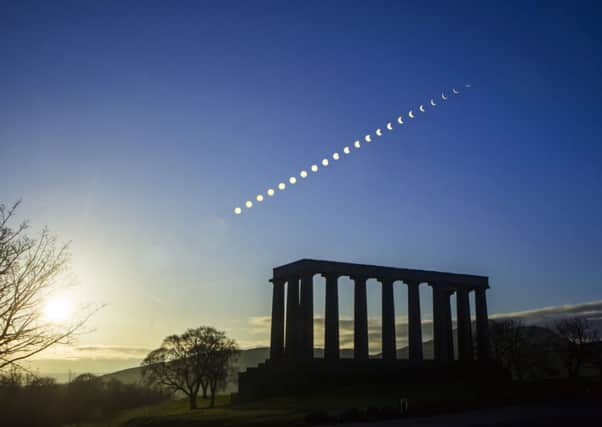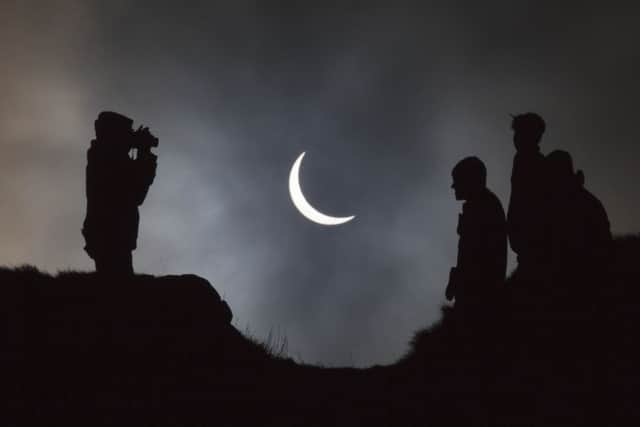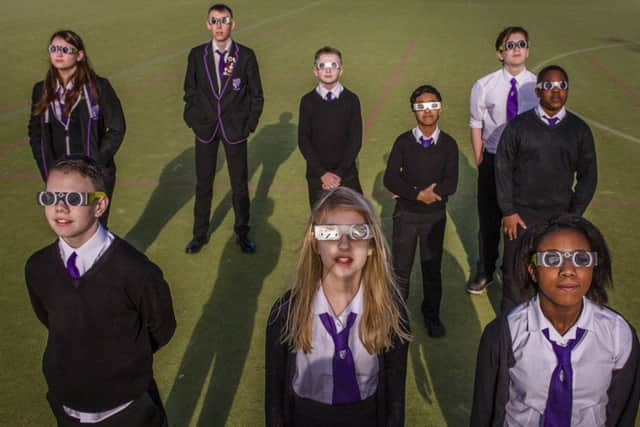Eclipse 2015: Edinburgh enjoys solar phenomenon


Hundreds gathered at beauty spots such as the Meadows and Portobello beach, as well as on the city’s hills from Arthur’s Seat to Corstorphine, to view the phenomenon as the clouds parted just enough to allow the moon to be seen as it passed the sun.
A joint Astronomy Society of Edinburgh and Scottish Parliament event hosted outside Holyrood saw hundreds flock to watch it through eclipse glasses and telescopes fitted with special solar lenses.
Advertisement
Hide AdAdvertisement
Hide AdAstronomy Society of Edinburgh chairman Ken Thomas, who also delivered a talk on the eclipse to more than 40 James Gillespie’s pupils, said: “It was a fantastic morning. It all turned out a lot better than we thought it would, Edinburgh did very well.


“There was forecast to be more than 90 per cent cloud cover which would have meant very little to see. It was brilliant to see so many people turned on to astronomy, it stopped the city for a number of minutes.”
He added: “It was great to see so many young people interested in the eclipse also. You can see they were really into it and excited by it which can only be a good thing.”
Further up the Royal Mile crowds also flocked to Camera Obscura to watch the spectacle on the tourist attraction’s viewing table, which it is believed was invented over two millennia ago for safely observing solar eclipses.
Advertisement
Hide AdAdvertisement
Hide AdManager Andrew Johnson opened the venue early at 8.30am to allow people a place to view “this wonder of nature.”


READ MORE
He said: “We had a big crowd of people through the doors, all ages and nationalities. People were viewing the eclipse through all sorts of contraptions. Everyone had a great time and our staff were on hand to tell people exactly what was happening.
“Where better to view it than through the Camera Obscura which was originally created for such a purpose?
“The cloud cover did help in allowing people to see it with their naked eye but the view through the camera obscura was so clear it was amazing.”
Advertisement
Hide AdAdvertisement
Hide AdIn Edinburgh the moon began passing in front of the sun shortly after 8.30am and peaked at 9.35am with up to 93 per cent of the sun’s surface covered.
Hundreds of pictures of the eclipse taken across Edinburgh have appeared on social media with people using a variety of methods to view the spectacle from homemade pinhole cameras to wearable helmets to vegetable colanders.
Around the UK, the proportion increased towards the north, ranging from 84 per cent in London to 89 per cent in Manchester, and 97 per cent in Lerwick in the Shetland Isles.
The last solar eclipse of such significance occurred on August 11, 1999, and was “total” – with 100 per cent of the sun covered – when seen from Cornwall.
Advertisement
Hide AdAdvertisement
Hide AdAnother “deep” partial eclipse visible in the UK will not occur until August 12, 2026, and the next total eclipse not until September 2090.
During the eclipse, the moon’s shadow raced across the Earth from west to east at up to 2000mph.
The eclipse produced a 100-mile-wide “totality” shadow path which sped over the North Atlantic and covered just two land masses, the Faroe Islands between Scotland and Iceland, and the Norwegian archipelago of Svalbard.